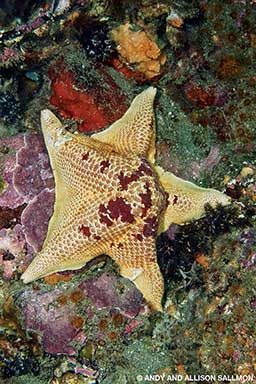Many West Coast divers weren’t aware of the change that was taking place in our waters in the summer of 2013, but Katie Kozma, a training coordinator for Reef Check California, almost immediately noticed a difference. She had learned to dive in San Diego’s local kelp beds, and she had a particular fondness for starfish; she looked forward to seeing their hues as she descended for her underwater surveys.
“Those colors always centered me. But one day I looked down during my descent, and the starfish were just gone,” she said. “Months before, there had been so many that I had to extrapolate numbers based on a portion of my survey area. And now I was looking into holes and crevices, hoping to count a single one. I knew something was really, really wrong.”
She was right. Starfish up and down the West Coast of North America had begun to disappear, victims of an enigmatic syndrome referred to as sea star wasting disease (SSWD). Although Kozma’s trained eye recognized the issue right away, it may not have been obvious to most recreational divers, even those who spend a lot of time in the water, because the progression of SSWD is incredibly rapid. Initial symptoms — a deflated appearance and lesions within the ectoderm — bear resemblance to numerous other afflictions, so they can go largely unnoticed. But once the disease process begins, it’s followed within days by tissue decay and disintegration.
Imagine you’re diving a reef one week, admiring the prolific life encrusting the rocks — sponges, sea fans, starfish and other invertebrates — and two weeks later you return to the same site and poof, the starfish are all gone, and everything else is unchanged. Many divers were unaware of the extent of the situation until they noticed, as I did, an almost unrecognizable starfish that seemed to have melted into the seafloor.

But numbers don’t lie. Although subtidal (diver) observations tended to be anecdotal, intertidal (tidepool) surveys allowed for systematic collection of quantitative data along the West Coast, leading to formal detection of the disease in Washington State in mid-2013. Ochre stars, the most common species in the habitat, were the first noticed to be affected, though it wasn’t long before news of other affected species in other locations along the coast began to trickle in, followed by diver accounts of the rapid disappearance of sunflower stars. Alarmed scientists within the Multi-Agency Rocky Intertidal Network (MARINe), a consortium of 18 monitoring groups, rapidly organized a collaborative project centered on starfish health. Utilizing both researchers and citizen scientists, they worked to track the extent and progression of the syndrome at more than 200 intertidal and subtidal sites. They estimate that 23 sea star species have been affected.
It’s critical to understand that while wasting syndromes affecting starfish had occurred before, this event was quite different; never had such a massive die-off affected such a huge geographic area. Melissa Miner, a scientist with the rocky intertidal monitoring group at the University of California, Santa Cruz, for more than 20 years, emphasized that the current phenomenon warranted a swift, coordinated response. “Prior outbreaks were cyclical, patchy and almost always associated with warm-water episodes,” Miner said. “This outbreak, however, was coastwide and wasn’t primarily dependent upon water temperatures. One of the worst die-offs during the recent outbreak occurred in Santa Barbara in the wintertime, for instance, when the water was relatively cold.”
Other single influences, such as density of starfish species or viral infection, have been shown not to be definitively associated with the current syndrome on a widespread basis. “Right now,” Miner said, “we and many other scientists believe that the cause of the outbreak was multifactorial.”

The absence of sea stars is a bigger deal than you might imagine — they’re far more than just picturesque reef inhabitants. Starfish are voracious hunters, with some species considered keystone or dominant predators; in other words, losing starfish for an extended time would almost certainly have major consequences on the ecosystem. Their prey includes numerous creatures such as whelks, barnacles, mussels and sea urchins. In the absence of a key predator, prey populations can propagate unchecked, sometimes resulting in devastating secondary outcomes.
Although numbers of certain species such as ochre stars have rebounded in some areas, numbers of others, such as sunflower stars, remain extremely low. Recent reports indicate new observations of SSWD-affected sea stars of multiple species (ochre and sunflower among them) in Washington and British Columbia as well as sightings of sick bat stars in Southern California. Miner wonders if it might be necessary to evaluate affected sea stars on a species-by-species basis in the future.
“If there’s one good thing that came out of this issue,” Miner said, “it’s that we really got organized in terms of collaboration. Having access to long-term monitoring data prior to an outbreak provides historical context and may help shed light on future patterns. It’s our best means of assessing the impact of this disease.”
How You Can Help
Learn more about sea star wasting syndrome, and access current tracking map, an observation log web form, ID guides and information about the citizen science groups contributing data. Submit your own observations today.
| © Alert Diver — Q4 2018 |